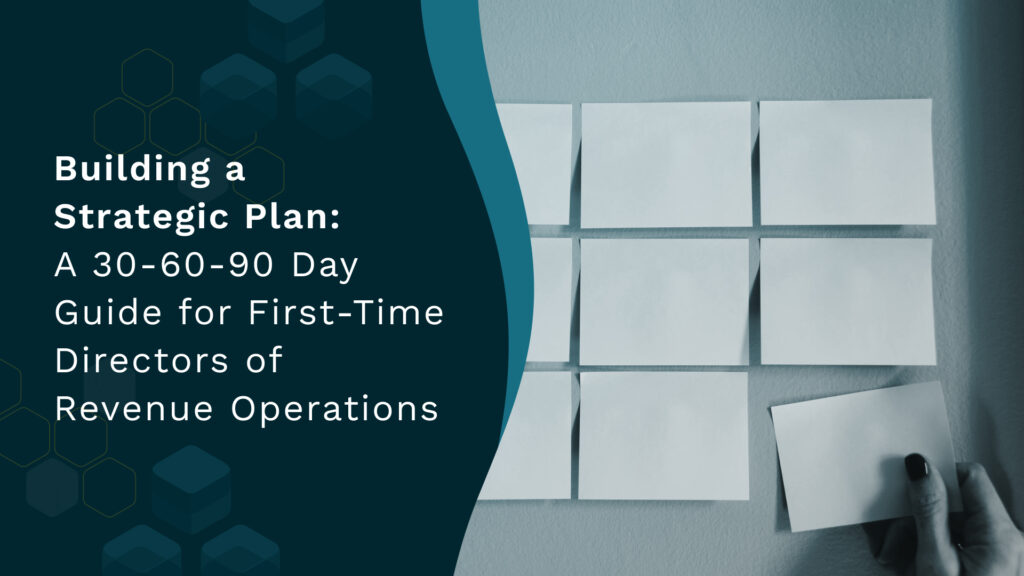
How RevOps Can Create Team Alignment to Drive Exceptional Customer Experience
Check out these actionable templates that show you how to create team alignment for exceptional customer experience.
2023 brings a lot of challenges to revenue leaders. In a time of budget freezes and a harsh economic climate, winning customers has never been harder. At the same time, locking in more revenue in the current uncertain economic climate demands an iron-clad focus on customer experience.
Siloed teams are the final nail in the coffin, compromising data processes, technology, and customer experience amidst a complex buying process.
Alignment is when the key pillars of revenue management – process, technology, and data – function similarly for all departments.
Team alignment is table stakes to drive efficient and effective growth. Especially in today’s age where businesses are more interconnected than ever. Having teams aligned will result in higher productivity, an integrated tech stack, seamless revenue management, data-driven decision-making, and superior customer experience.
Yet, the reality is quite different.
Nearly 9 in 10 sales and marketing professionals frown upon misalignment between their teams. This problem comes with severe repercussions because misalignment equals missed revenue opportunities. It costs teams a sizable revenue loss of as much as $1 trillion annually.
Help Comes in the Form of Revops
RevOps steers alignment so all teams can function optimally to achieve business success.
We’ll learn more about how RevOps does it from Jeff Ignacio, Head of GTM Operations and Growth at Regrow Ag.
This blog discusses how to create team alignment through RevOps for exceptional customer experience. For the full interview, check out the podcast.
Customer Experience Problems Risk Business Growth
Conventionally, sales, marketing, and customer success teams functioned in silos. Each team had different goals, frameworks, and processes, creating friction and confusion.
This no longer works.
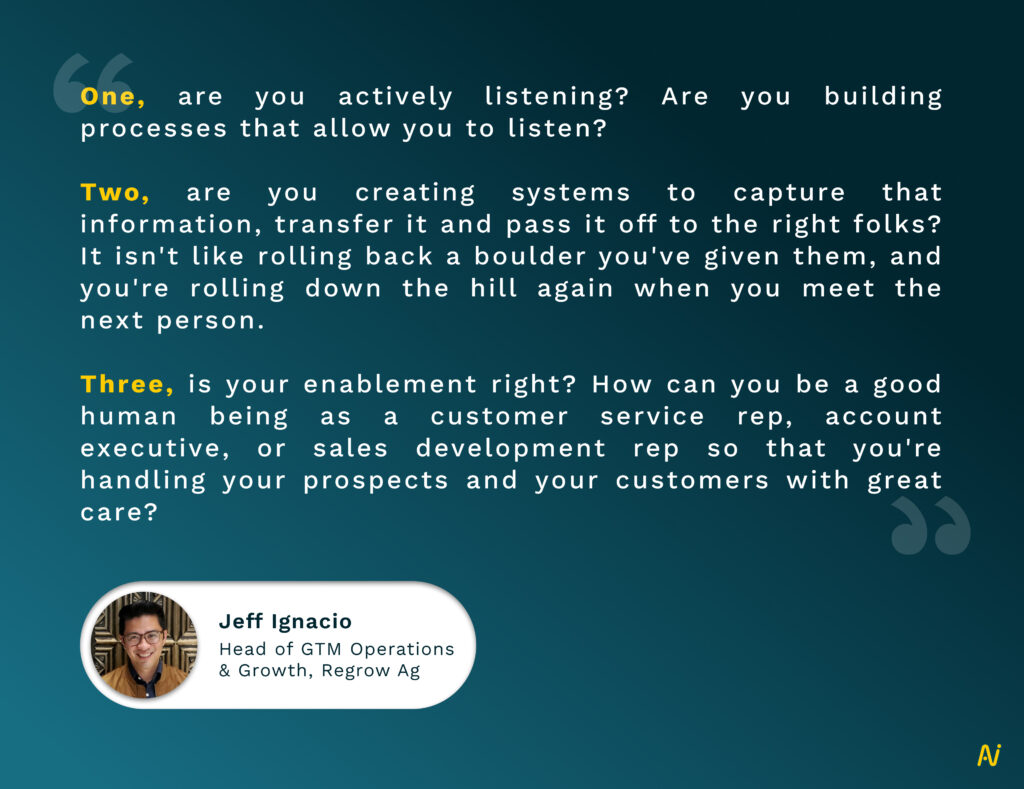
The buying process is getting more complex, with anywhere between 6 and 10 stakeholders involved in a single deal. Each stakeholder undertakes independent research.
More and more buyers are unwilling to interact with sales reps today. Only 24% of B2B buyers completed high-quality deals in sales rep-led purchases. And they spend as little as 5-6% of their time with a seller.
Instead, the customer journey spreads across multiple teams, and no single department owns a lead. As customers pass through various sales cycle stages, the lack of a single view across their journey creates a fragmented buying experience.
RevOps forms a path for alignment by putting you in the buyer’s shoes. You then think backward about creating team alignment from a people, process, and technology perspective.
How to Create Team Alignment for Exceptional Customer Experience?
Our conversation with Jeff gave us deep insights into how to create team alignment using a 4-step framework. Here’s what we put together for revenue growth.
Step 1: Set up Common Frameworks
59% of senior executives confess that their organizations struggle to bridge the gap between strategy development and day-to-day implementation.
A common framework among teams solves implementation challenges and sets a strong foundation for alignment. It includes two key elements – common goals and common data language.
a. Common Goals
Common or shared goals shift the focus from individual teams to joint strategic initiatives for the business. They allow for successful outcomes through collaborative efforts coupled with individual autonomy.
To set up common goals, Jess suggests two approaches:
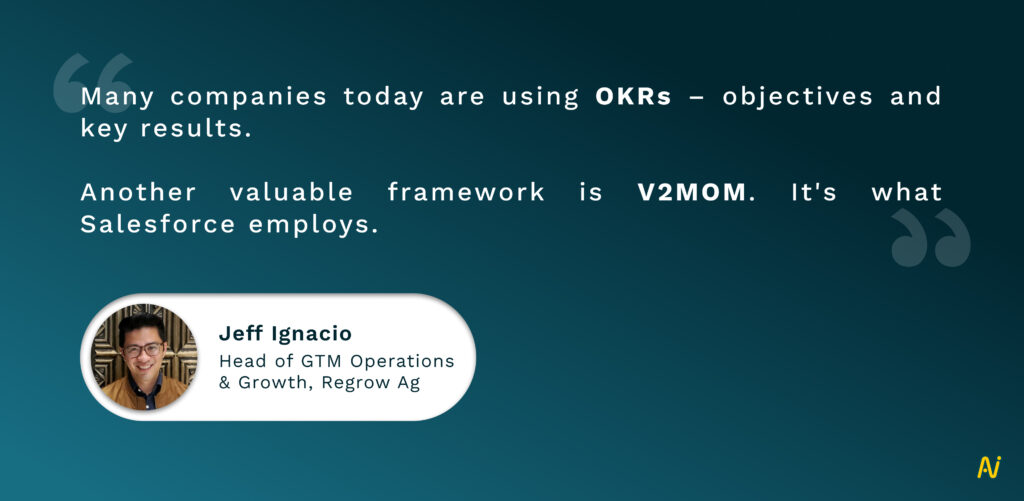
(i) Objectives & Key Results (OKRs)
This approach sets measurable goals and tracks them—each objective you want to achieve pairs with the results you need to measure progress.
OKRs tie your overarching business goals to the teams’ daily activities. The approach can be both qualitative and quantitative.
An example would be:
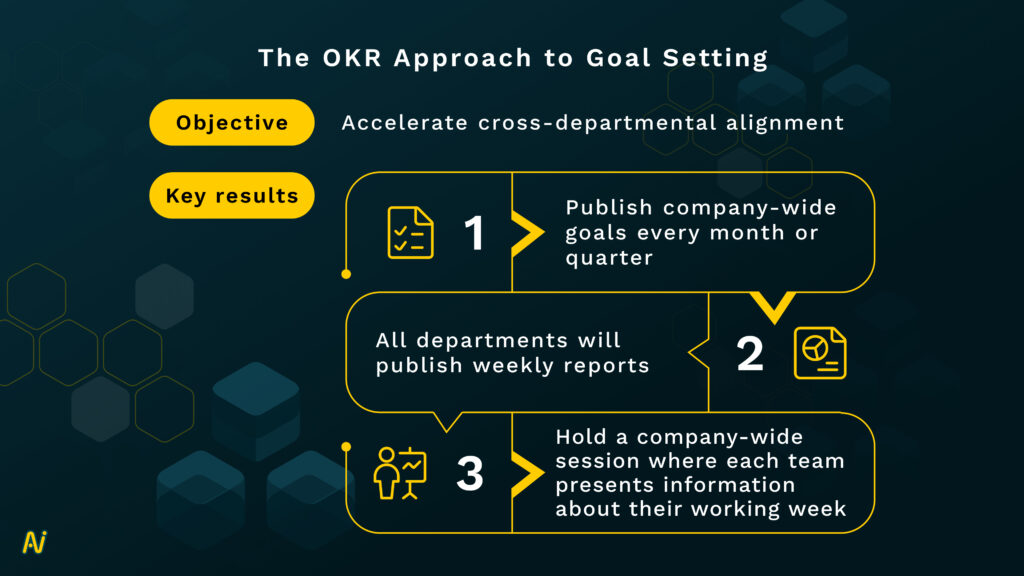
(ii) Vision, Values, Methods, Obstacles, Measures (V2MOM)
V2MOM, popularized by Salesforce, is a detailed map showing where your organization should be headed and how to get there.
Vision is the starting point of your map followed by the path to team alignment.
It includes the following:
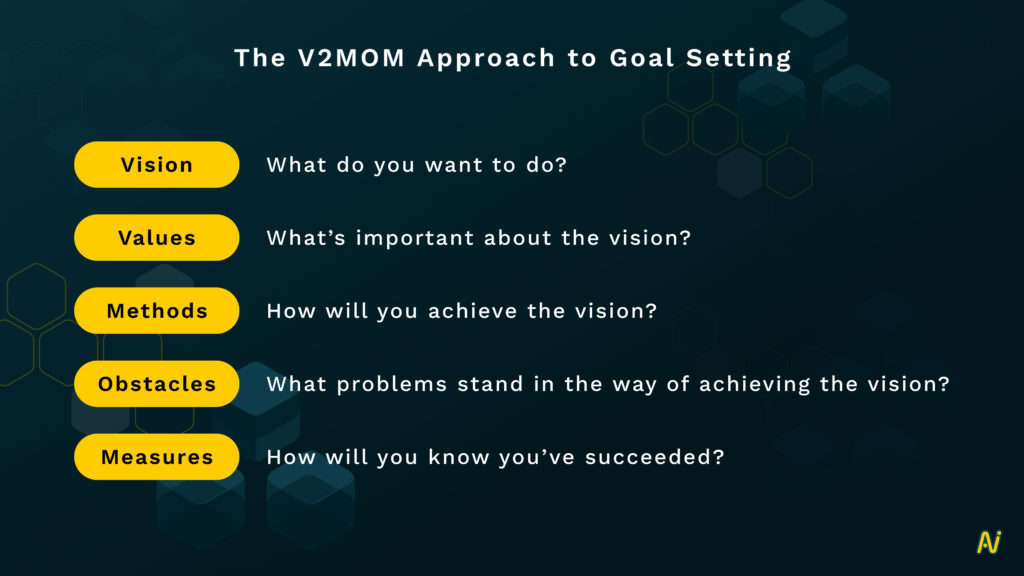
b. Common Data Language
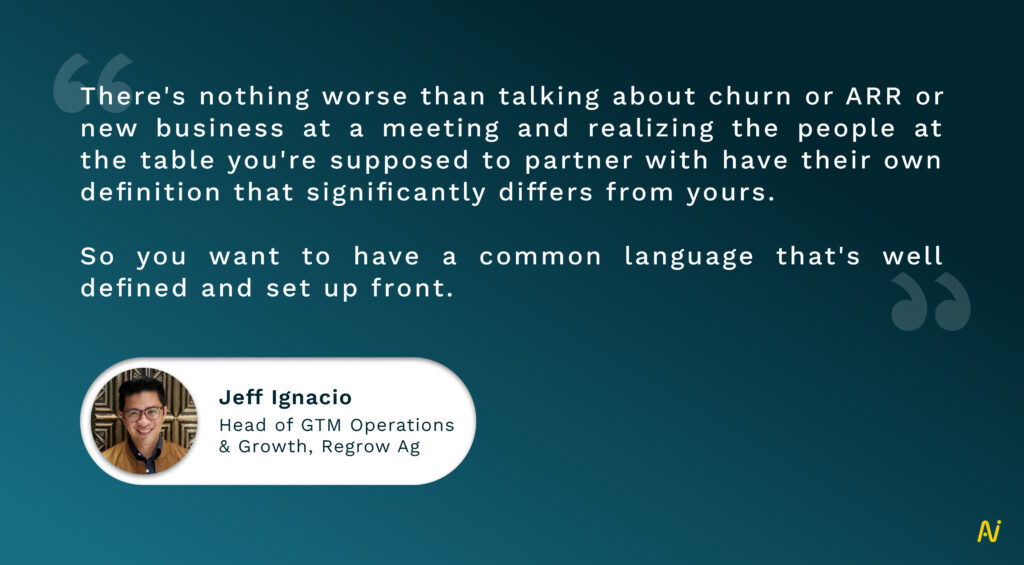
How can you create team alignment with a common language?
You can smooth out the collaboration kinks among revenue teams by agreeing on uniform terminology and metrics.
Start with setting up a data dictionary. It develops a better understanding of relevant concepts and brings teams on the same page faster. For instance, naming conventions for job positions must be Sr. Manager or Senior Manager across all teams.
Next, outline important data definitions within this dictionary.
An example would be the term MQL. Marketing may qualify MQL as a lead they’ve brought into the system with first-level account details. But sales may want the MQL checked against the ICP and only then passed on to the next phase. A data definition for MQL will solve the problem.
Once you have common goals and a common language, it’s time to build a common framework.
c. How to Create Team Alignment With a Common Framework
Start by setting common or shared goals for the company at every level (from managers to reps).
Next, decide who should be involved in creating the framework. These people should be the right ones to set goals.
Just like learning a new language needs practice, setting goals and settling on a common data language should be an ongoing process. Gradually, teams will start speaking the same language.
You can get GTM teams to shadow each other on the ground, so they understand each other’s challenges and KPIs. Also, undertake regular cross-functional meetings wherein teams share their achievements, ideas, and feedback. These meetings also help plan adjustments to common goals and the common language.
Step 2: Fall In Step With Rhythms of the Business
On average, organizations fail to meet nearly 20% of strategic objectives due to poor implementation. Rhythms of the business show how to create team alignment with proper implementation.
As Jeff points out,
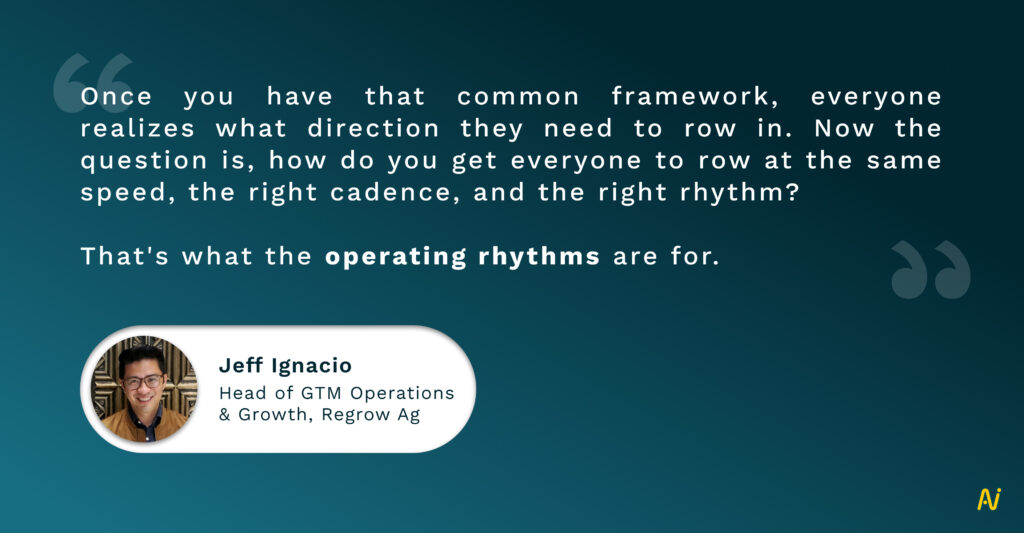
Rhythms of the business visually map out key events, milestones, and activities scheduled in the business year. They also record long-term events and activities.
We discussed four cadences of rhythms of the business with Jeff.
a. Communication & Engagement
This cadence tracks communication to plan, direct and receive feedback for business performance. It involves two types of meetings:
(i) Team Meetings
At the team level, the communication and engagement cadence discusses wins, misses, key topics, and requests for help. These topics are relevant to the entire team.
Team meetings summarize clear action points or next steps.
The meetings could also be direct weekly reports between each team and multiple teams. For instance, marketing will have its team meeting. But it will also exchange updates with sales and customer success.
(ii) All Hands
This type of meeting increases visibility across all teams, connecting strategy to execution.
It has a broader agenda than team meetings, touching upon the following:
- Overall business performance
- Key initiatives
- Special topics
- Introducing new hires
- Q&A with managers or leaders, among other items.
All-hands meetings set a clear focus for the teams every month or quarter. Generally, all members from all teams attend the meetings. They document the next steps for the entire organization.
b. Planning Reviews
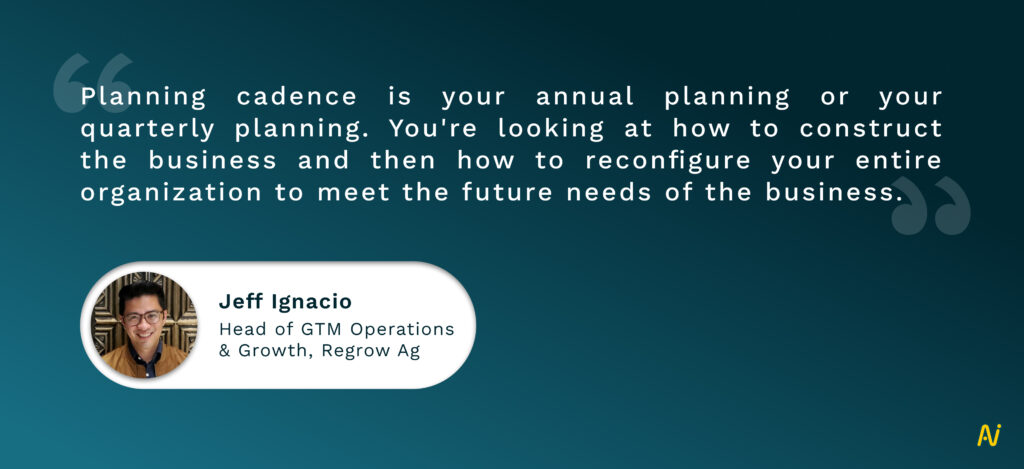
Planning reviews are generally held every quarter or annually. This cadence adjusts focus from individual goals to the larger business picture from time to time.
It evaluates past performance, clarifies future objectives, refines the vision or goal framework, and recalibrates RevOps alignment. These meetings also celebrate big wins and highlight the lessons learned from losses.
Each review follows a theme (a primary goal/vision) for the year or quarter. This theme is partnered with critical numbers (KPIs) to compare the company’s performance for this particular theme.
Here’s an example:
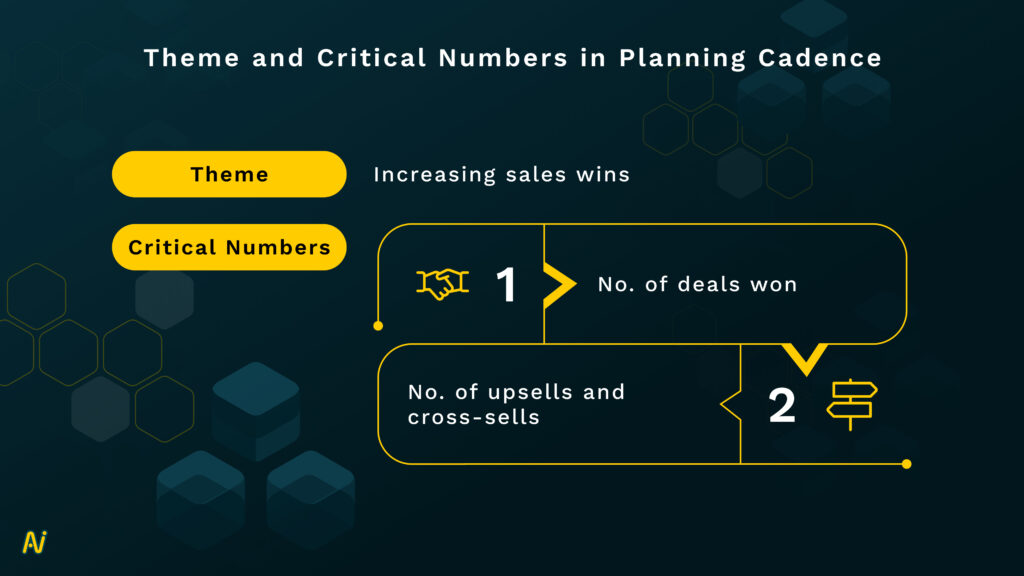
c. Operating Cadence
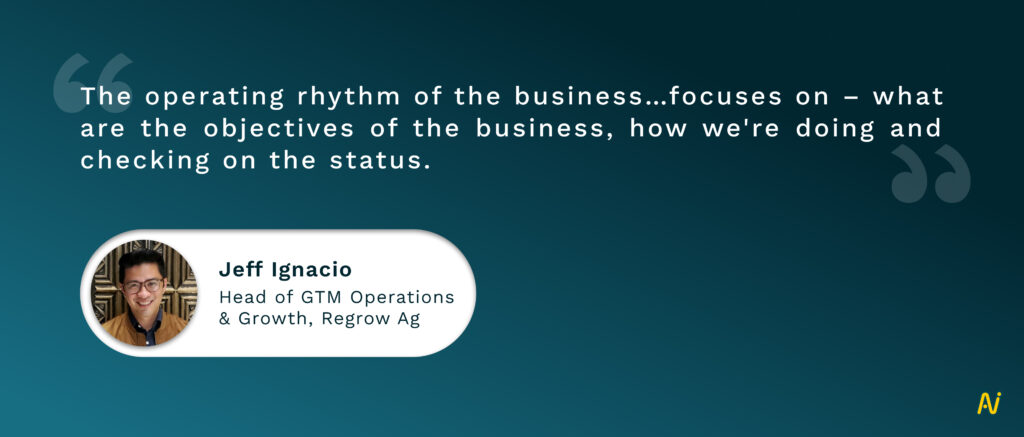
Operating cadence looks at everyday tasks or recurring operational activities. It then maps milestones for team alignment based on these activities. Teams then check up on each other’s performance against company objectives.
Operating cadence meetings allow each team to report progress and request help wherever needed. It also aligns resources for solving problems or removing obstacles.
It creates team alignment by pushing RevOps to drive full-funnel accountability and operational uniformity.
At the same time, as they check up on each other’s progress, revenue teams maintain autonomous processes. Therefore, regular updates and staying in rhythm with each other are essential.
The fourth cadence – interlocking cadence – plays a more prominent role in the team alignment puzzle at a later stage. It’s discussed separately in Step 4.
Step 3: Incorporate Data Governance
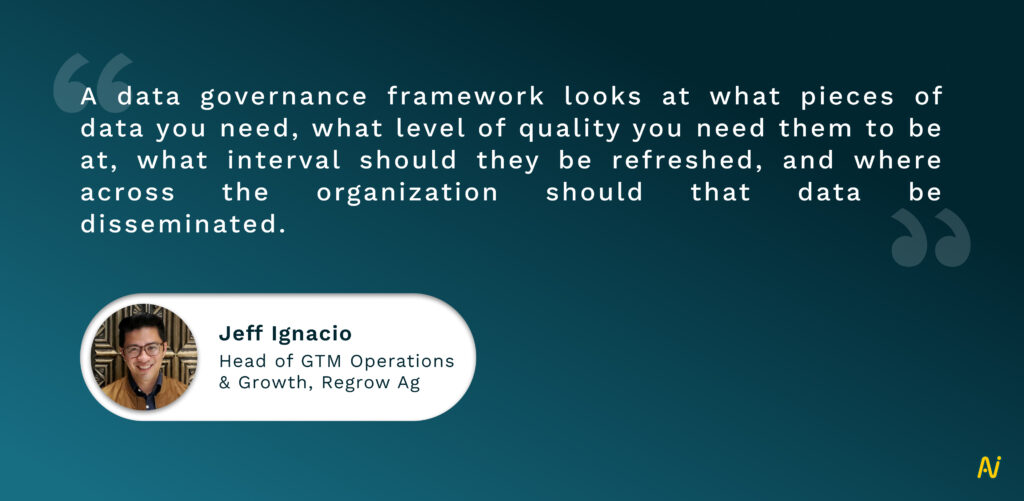
How can you create team alignment with data governance?
Driving a data culture within the organization starts with collecting quality data, managing it, and creating processes to ensure it happens repeatedly. That’s what data governance helps with.
a. The Building Blocks of Data Governance
The two main elements of data governance are quality data and unified data.
(i) Quality Data
RevOps guides teams successfully by operating with valuable, complete, correct, and relevant data. But what if it doesn’t have good-quality data at its disposal?
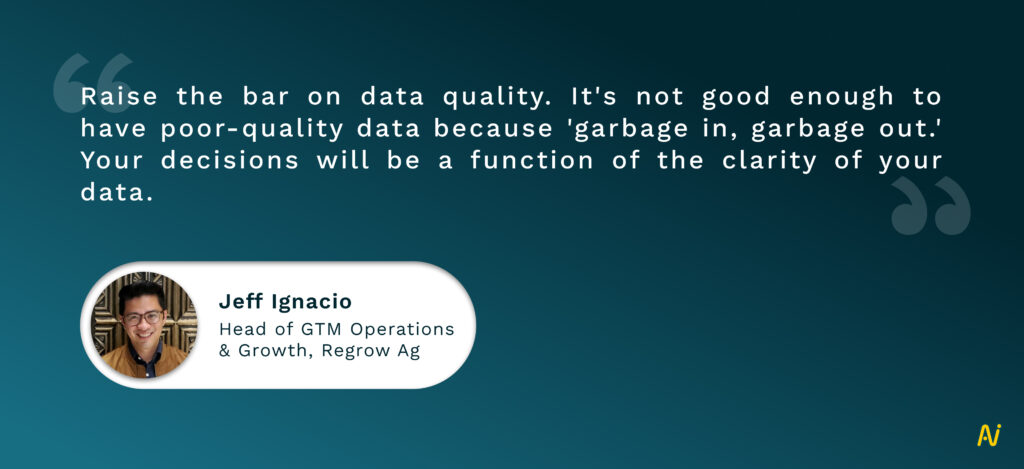
You can’t trust poor-quality data. It leads to you running the business more on gut-based decisions. 85% of data leaders agree that making decisions based on dirty data costs the organization financially.
Buyers want you to understand their needs and exceed their expectations. But muddled insights restrict deal personalization opportunities. As a result, poor quality data in the CRM causes 56% of sales reps to lose existing customers while 51% lose new deals.
Bad data leads to low-quality insights that drive bad decisions and, eventually, poor revenue.
So, how to create team alignment by improving data quality?
Jeff lays down some crucial steps to ensure you capture quality data and maintain it:
- Know what data you need to capture
For example, if you’re in sales or marketing, you should know if your prospect is ICP-compliant. Or if they’ve had previous interactions with someone from the team.
- Know where to get the data from
You could have a third-party vendor to enrich your platform. Plus, you could have seller-generated data from customer interactions. This data can be captured via forms or emails.
- Sync all your data systems
You can then organize all the information you have, collect insights and use them to take action. That’s what unified data helps with.
(ii) Unified Data
The average sales tech stack has 13 tools today. That’s just sales; marketing and customer success have their own.
More tools don’t equal more revenue. On the contrary, it could worsen the data problem by scattering it across disconnected systems. With so many poorly integrated tools, 50% of employees struggle to share information seamlessly between teams.
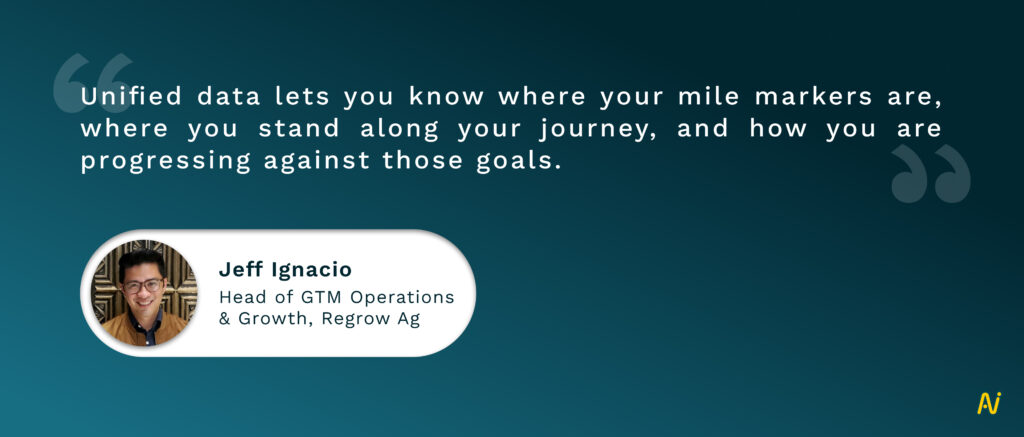
Unified data combines data from disintegrated systems into a single, centralized view.
Each team can use unified data to its advantage. For instance, marketing can use sales to connect campaign objectives, and performance to revenue and nurture leads with relevant content.
b. Developing the Data Governance Framework
Here are the steps you should follow to create team alignment:
(i) Define Your Data Life Cycle
Create an activity diagram of how you want to define your data life cycle.
One activity could be: Capturing leads from different sources (events, web forms, and live imports).
This data moves into the CRM or marketing automation platform. Here, you can assign responsibility for lead handoffs to create a valuable customer experience.
(ii) Layer on KPIs
Within each node of the activity diagram, layer on KPIs for that activity. An example would be SDR’s ultimate result: “How many qualified meetings are we setting?”
You could layer on KPIs like call connect rate, i.e., how many conversations led to positive interactions. You can further slice this data to “what time did you call.”
Find ways to optimize these KPIs and tune the revenue engine.
(iii) Establish a Systems View
Disintegrated revenue systems restrict the seamless flow of data from end to end. A systems view unifies a disaggregated tech stack for ease of sharing data.
Most organizations start with capturing data through the website.
Secondly, it’s about determining where the captured data will go – will it go into the CRM or some other marketing automation platform?
Third, you need to figure out how to use the data for forecasts, pipeline reviews, designing territories, and focusing on upsells or renewals.
You can answer all these questions with a centralized tech stack.
Data governance opens up possibilities to interrelate different parts of the organizational tech stack and understand how each system works within the context of a larger one.
It helps RevOps optimize the customer experience across the sales cycle.
Step 4: Tie It All Together With Interlocking Cadences
Interlocking cadence bridges different layers of the organization. It breaks down silos between revenue teams, cutting down upstream and downstream risks.
Instead of information flowing from top to bottom and vice versa, interlocking cadence ensures it flows seamlessly across the organization.
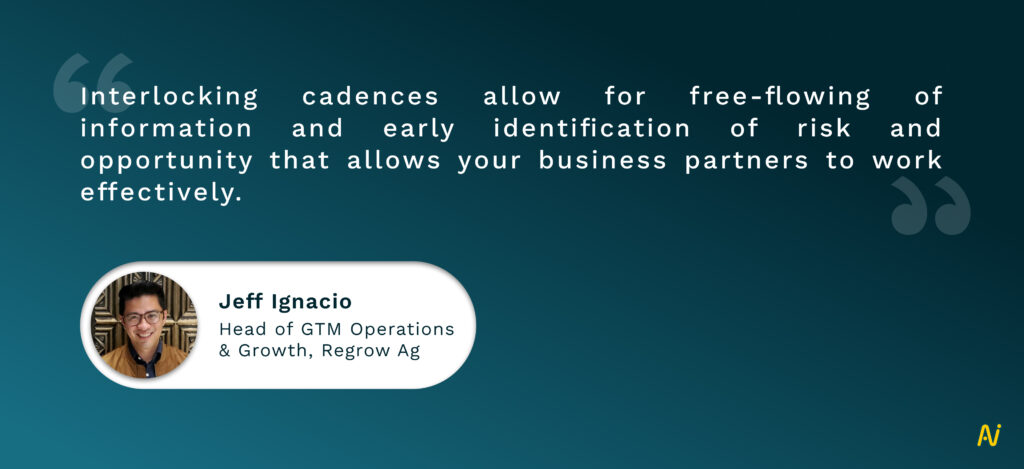
Given their strategic significance, these meetings are generally for senior leaders and top-level executives.
Here’s how you can create team alignment using an interlocking cadence.
a. Streamline Marketing & Sales Ops Interface
Heads of marketing and sales teams need to exchange information freely. But sometimes, downstream or upstream communication impacts meaningful work. In these times, information needs to move faster, which interlocking cadences help with.
It lets you focus on the big projects, understand design choices and trade-offs, and determine the overall impact on processes.
Interlocking cadence also gives you a clearer view of what’s coming your way through the pipeline via – ICPs, type of accounts, and stakeholder personas.
b. Review GTM Launch Readiness
Interlocking cadences prepare your systems for GTM launches. They connect four parts of the GTM wheel:
- Product is the series of products or features you use to solve customer pain points.
- Marketing takes care of positioning the product in the market.
- Sales define the roles and responsibilities of sales reps and their general availability.
- Finance figures out the resources to meet GTM goals.
c. Set Up Frictionless Systems
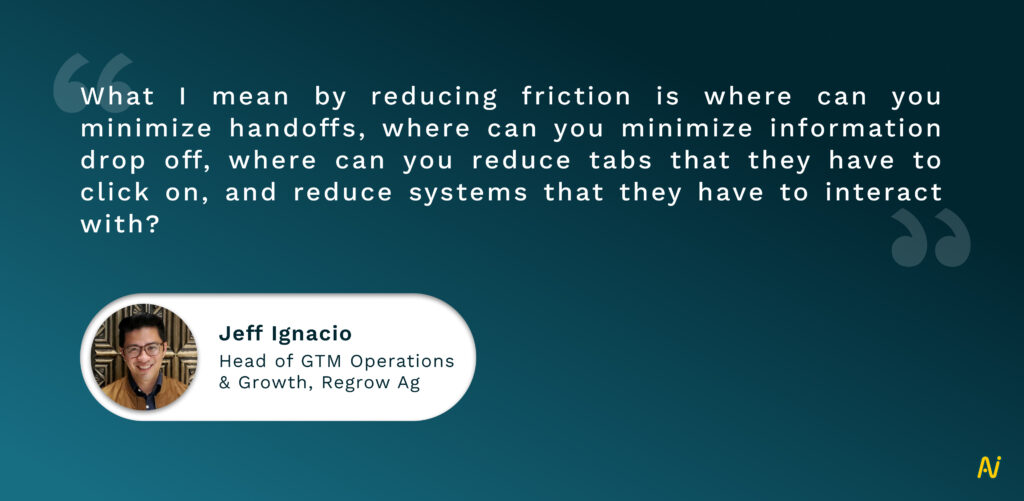
Interlocking cadences minimize handoffs through a uniform set of platforms or just one platform for all revenue teams.
They bridge the gaps in the customer journey by mapping out how data is connected between systems.
Interlocking cadences ultimately bring together common goals, common data language, rhythms of the business, quality data, and unified data to review past performance and plan for the future.
RevOps is responsible for bringing this herculean task to fruition.
This process solidifies the team alignment journey. However, you should cover a few bases to connect all systems for a seamless customer experience.
Covering the Last Mile of Team Alignment for Superior Customer Experience
To optimize your revenue engine, ensure you see through the processes below.
1. Go to the Root Cause of Misalignment – Improper Prioritizing
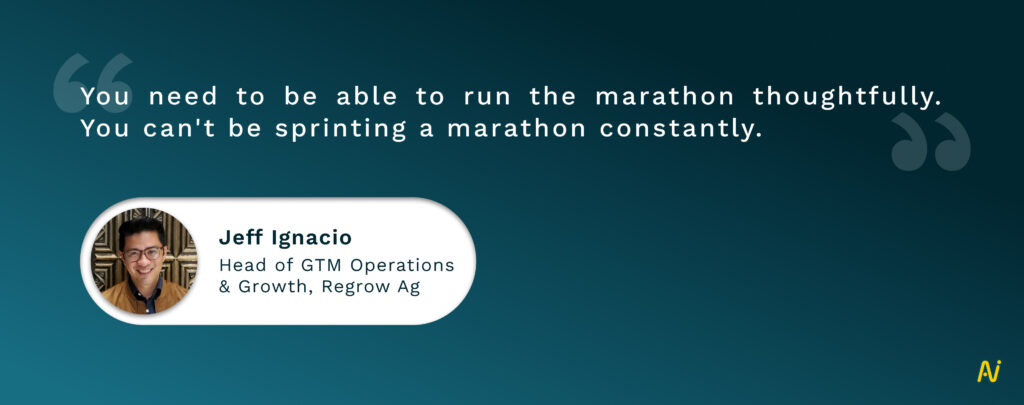
Several requests move through RevOps, seeking help in problem areas. However, improper prioritization creates significant challenges for alignment.
To overcome this, Jeff uses a weighted scorecard approach:
- P0 (this is a non-negotiable)
- P1 (it’s urgent and important)
- P2 (not urgent but important)
- P3 (not urgent, not important)
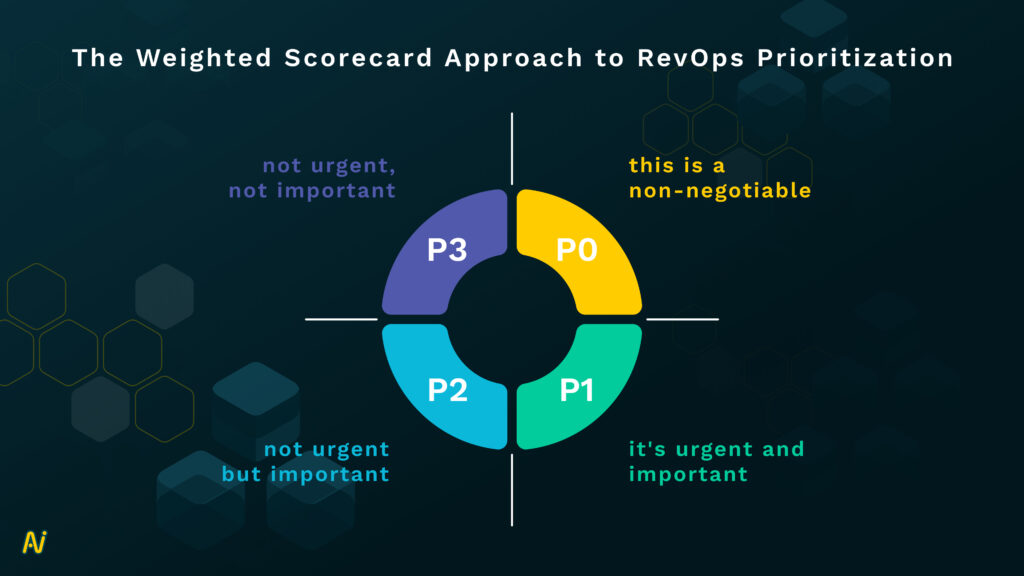
But to avoid creating friction, build trust by communicating effectively. Then allocate resources accordingly to tackle the problems effectively.
2. Take Care of All Customer Experience Touchpoints
Ensure your teams are aligned across three key customer touchpoints.
a. Product Awareness
This initial interaction builds brand awareness for customers. It depends on what messaging you put forth, what channels you use, or what events you’re present at.
b. Information Gathering
Once buyers know about you, they look for any information regarding your products. They can turn to customer reviews on online platforms like G2, Capterra, and Software Advice.
Alternatively, they could connect with past customers or post questions in relevant buyer communities.
c. Rep Engagement
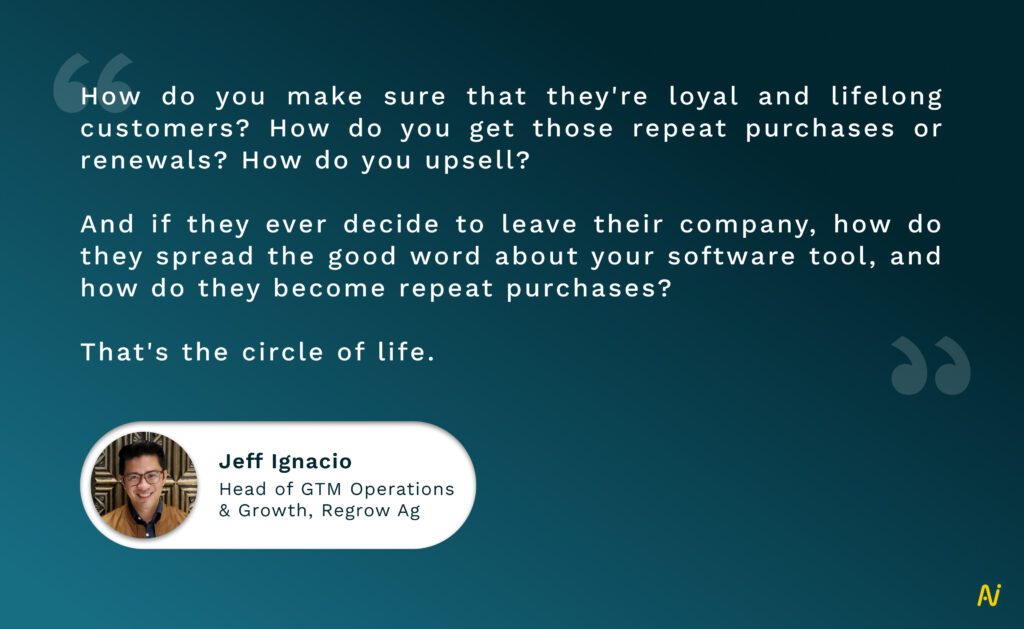
A key consideration here is “how to help the buyer navigate the product landscape?” Mainly if you’re selling something that never existed before. Implementation becomes important. You must ensure the buyer knows what value they get in return.
Sellers who can provide comprehensive answers about their offerings, efficiently manage the growing number of stakeholders, and prompt direct buyers to the best solution are more likely to win deals.
As much as 80% of buyers are more inclined to purchase from consultative sellers.
As a Leader, You Can Do Better
Unless you know what’s happening on the ground, you won’t know how to create team alignment.
Listen to sales calls, go to a demo with reps, and understand how they manage buying committees. This empathetic approach helps you redesign processes for a better customer and prospecting experience.

If you enjoyed this blog on how to create team alignment with RevOps, check out more episodes of our podcast. You can follow on iTunes, Spotify, YouTube or grab the RSS feed in your player of choice.

PUBLISHED BY
